This tutorial will take you through the concepts of Blood Pressure and its regulation.
You can navigate through this tutorial using the buttons at the top of the screen.
The tutorial will ask you questions. Click on your chosen answer to see feedback; click the answer again to make the feedback disappear. When you're finished with one page, click the navigation button for the next page to move ahead.
Have fun! Click on button '1' to see the first page of the tutorial.
Page 1

As blood is pushed through your arteries by the beating of your heart, it also pushes against the walls of the arteries. This is the pressure you measure when you put a blood pressure cuff around someone's arm; the pressure the blood exerts against the wall of the artery.
Page 2
Cardiac Output
The harder the heart beats and the more blood it pumps, the more pressure it will exert against the walls of the arteries.
Think of the heart as a bicycle pump; the faster you pump and the bigger strokes of the pump you take, the higher the pressure will go in the tube carrying air out of the pump.
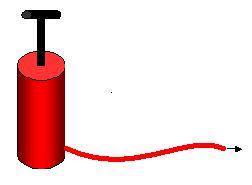
The amount of blood pumped by the heart is called the CARDIAC OUTPUT, and is given in mL of blood per minute.
CARDIAC OUTPUT (CO) can be affected by two things:
1. How fast the heart beats, or HEART RATE (HR)
2. How much blood it moves with every beat, or STROKE VOLUME (SV)
In fact, to calculate cardiac output you use this equation:
CO = HR x SV
If a man's heart beats 65 beats a minute, and each beat moves 60 mL of blood, what is his cardiac output?
Page 3
Blood Pressure depends on Cardiac Output. The higher the Cardiac Output is, the higher the blood pressure will be. Which of these conditions would INCREASE cardiac output?Page 4

Suppose you are pumping up your bicycle tire. The harder you pump, the higher the pressure in the hose will be.
What would happen if somebody put a box down on the end of the hose?
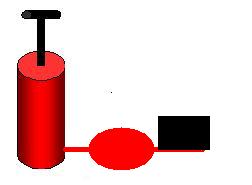
If the end of the hose is compressed, less air will get out. The hose will swell because the pressure inside it is higher -- air is coming in from the pump, but not going out as fast as it comes in.
This happens in your blood vessels too.
If something partly blocks one of your arteries, it will be harder to push blood through that spot and the artery between that point and the heart will have higher pressure in it.
Page 5

When something reduces blood flow through an artery, it RESISTS the blood flow. So the blockage is said to increase the artery's RESISTANCE.
Since the blockage has occurred at the end of the artery -- out in the body's tissues rather than at the heart -- it is called PERIPHERAL RESISTANCE, or PR.
In hospitals, it is often called SYSTEMIC VASCULAR RESISTANCE or SVR. This term is a little more accurate, because it tells you that the vessels involved are in the body - the SYSTEMIC circuit - rather than in the lungs.
Of course, nobody is setting a box on your arteries to block blood flow through them! Instead, the blood flow through your blood vessels is regulated by rings of muscle around the arterioles. These rings of muscle are called SPHINCTERS.
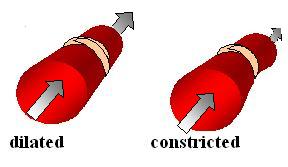
When the sphincters open, blood can flow freely through the DILATED arterioles. The RESISTANCE to blood flow is low, so the blood pressure is low too.
When the sphincters CONSTRICT, they resist the blood flow through the arteriole. Now RESISTANCE is high, blood can't flow through the arterioles freely, and the blood pressure in the arteries will increase.
Page 6
How could this be a good thing? Isn't it bad for tissues to not get enough blood flow?

Actually, you don't have enough blood for all your tissues. You open and close your arteriolar sphincters all the time, so your tissues can take turns having the blood.
When you eat, you dilate the arterioles in your GI tract and send blood to help with digestion.
When you exercise, you dilate the arterioles in your muscles and send blood to bring them oxygen and food.
And when your blood pressure drops, you use the sympathetic system to constrict the arterioles in your GI tract, your skin, and your kidneys. This raises the blood pressure in your major arteries and sends more blood to your heart, lungs, and brain.
Page 7
Your arterial blood pressure depends on two things, then:
How much blood is pumped into the arteries, or your CARDIAC OUTPUT
and how easy it is for blood to flow out of the arteries through the arterioles into the tissues, or your PERIPHERAL RESISTANCE.
This leads to the summary equation of blood pressure:
BP = CO x PR (or SVR)
Here are some factors that can change your blood pressure: Can you pick out which ones change blood pressure by altering cardiac output?
increased heart rate
vasoconstriction
vasodilation
weaker heart beat
fatty buildup in the arteries
smaller heart
stronger heart
increased blood volume
dehydration
blood loss
Page 8
BP = CO x PR (or SVR)
Suppose you lose a lot of blood. Your STROKE VOLUME has decreased. Which two of these factors might help right away, to keep your CARDIAC OUTPUT normal?
increased heart rate
vasoconstriction
vasodilation
weaker heart beat
fatty buildup in the arteries
smaller heart
stronger heart
increased blood volume
dehydration
blood loss
Page 9
BP = CO x PR (or SVR)
increased heart rate
vasoconstriction
vasodilation
weaker heart beat
fatty buildup in the arteries
smaller heart
stronger heart
increased blood volume
dehydration
blood loss
Page 10
So to raise your blood pressure quickly, you have basically three responses:
stronger heart beat
faster heart beat
vasoconstrict
What system will do all of that for you?
Page 11
Bottom line: if your blood pressure drops, you need to turn on the sympathetic system. But how does your body know it needs to do this?
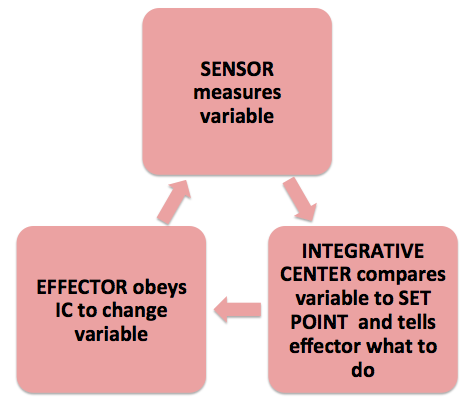
Remember the basics of a negative feedback loop:
A SENSOR measures the variable being controlled, and sends its results to an INTEGRATIVE CENTER.
The INTEGRATIVE CENTER compares the variable to its SET POINT and decides whether the variable needs to be raised or lowered. It uses the nervous system or endocrine system (or both) to send a message to the EFFECTORS that can do something to raise or lower the variable.
The EFFECTORS adjust the variable.
After the variable's been adjusted, the SENSOR measures it again and the cycle continues.
Now, how does this work for blood pressure?
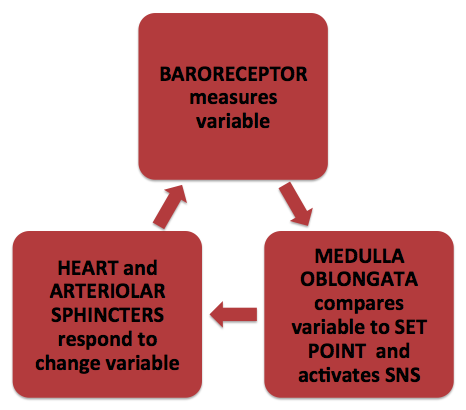
To start out with, the sensors measuring blood pressure are called BARORECEPTORS (like a barometer; 'baro' means pressure). Baroreceptors are actually stretch receptors in your aorta and carotid arteries; they measure how much the blood is stretching those important arteries.
The INTEGRATIVE CENTERS that receive information about the blood pressure are in your MEDULLA OBLONGATA, the base of your brain. There are two groups of cells that get the information: the CARDIOREGULATORY CENTER, which regulates your heart, and the VASOMOTOR CENTER that controls vasodilation and vasoconstriction.
These centers control the heart and blood vessels by turning the SYMPATHETIC and PARASYMPATHETIC systems up and down. The heart and blood vessels then adjust blood pressure by changing heart rate and strength, and by vasodilating and vasoconstricting.
Page 12
How would this system respond if your bood pressure went up too high? Choose the right answers to fill in the flow chart.
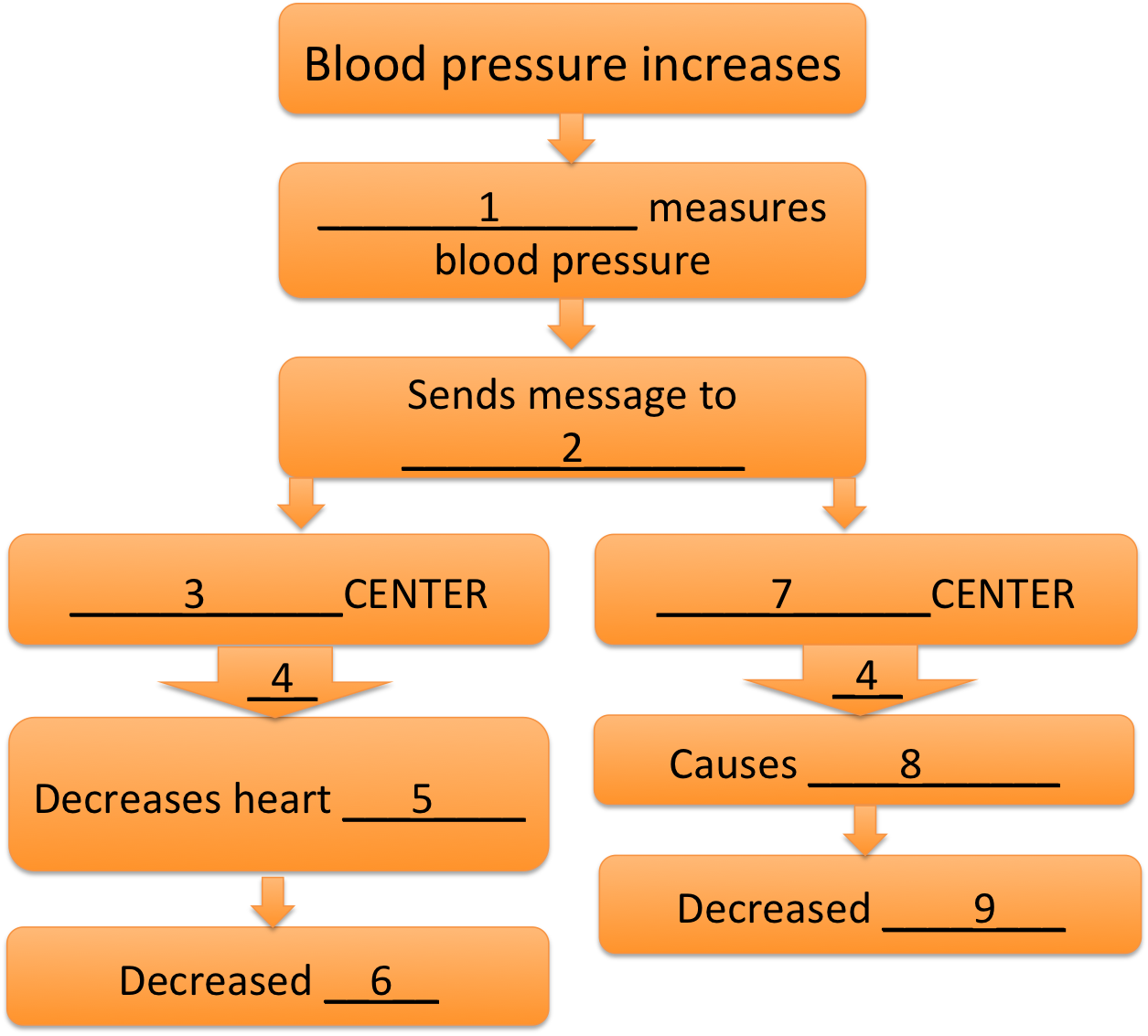
When blood pressure rises, it is measured by the (1): aorta / dermal pressure sensors / baroreceptors
These sensors send information about the blood pressure to integrative centers in the (2): motor cortex / medulla oblongata / carotid arteries
The integrative center in charge of heart function is (3): cardiac output / sympathetic system / cardioregulatory centerIn this case the blood pressure was high. Will the regulatory center want to send sympathetic or parasympathetic impulses to the heart? sympathetic, to inhibit the heart / sympathetic, to stimulate the heart / parasympathetic, to inhibit the heart
So what will the heart actually do in response (5)? decrease heart rate and increase heart strength / decrease heart rate and heart strength / decrease heart strength and increase heart rate
And what component of blood pressure will this affect (6)? peripheral resistance / Cardiac output
On the other half of the flow chart, baroreceptor impulses are going to a second center in the medulla (7). What is it? respiratory center / Baromotor center / Vasomotor center
Since the blood pressure is too high, this center will cause (8): decreased heart rate / vasoconstriction / vasodilation
And what component of blood pressure will this affect (6)? peripheral resistance / Cardiac outputPage 13
Good work filling in the flow chart!

So in summary:
BP = CO x PR (or SVR)
And your body uses the BARORECEPTOR reflex to control both CO and PR, by turning the sympathetic system up to raise them and the parasympathetic system up to lower them.
If it's working right, it should keep your blood pressure within normal limits, day and night! But what if part of this didn't work, or worked too much? Consider that as you review.
Happy studying!